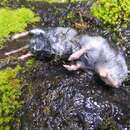en
names in breadcrumbs


Perception Channels: tactile ; chemical
White-footed voles are thought to be one of the rarest microtine rodents north of Mexico. They may, however, be more common than currently believed since being arboreal makes them hard to observe or trap from the ground.
IUCN Red List of Threatened Species: least concern
These voles eat roots and a wide variety of leaves from those of grasses to deciduous trees. They are also known to consume mosses and pollen. Other than parasites (which are presumed to be ingested during grooming) they are not thought to eat any animals.
Oregon and costal northern California
Biogeographic Regions: nearctic (Native )
These animals are generally found close to small streams and are often found near fallen trees. They exist from sea-level to over 1000 meters. They are most abundant in deciduous forest, although they have been observed in all types of forest found in their range.
Terrestrial Biomes: forest
Other Physical Features: endothermic ; bilateral symmetry
White-footed voles reproduce throughout the year. Their mean litter size is 3.0. Little is known about their fetal development or post-natal development.
Key Reproductive Features: gonochoric/gonochoristic/dioecious (sexes separate); sexual
The white-footed vole (Arborimus albipes) is a species of rodent in the family Cricetidae.[2] It is found only in the United States. Its natural habitat is temperate forests.
The white-footed vole (Arborimus albipes) is a species of rodent in the family Cricetidae. It is found only in the United States. Its natural habitat is temperate forests.